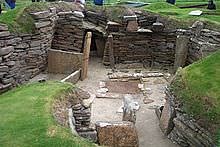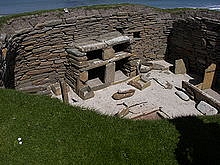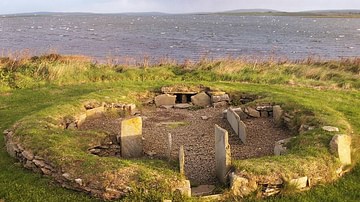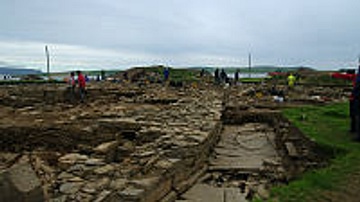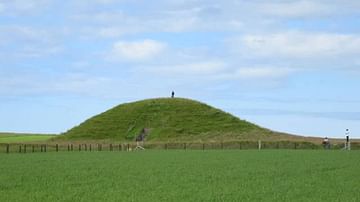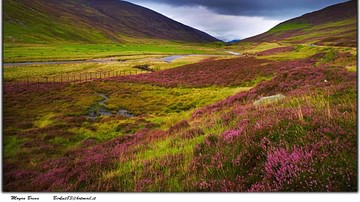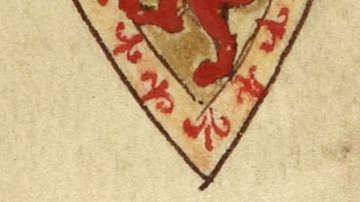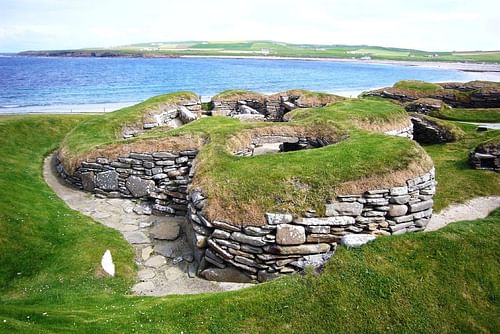
Skara Brae is a Neolithic Age site, consisting of ten stone structures, near the Bay of Skaill, Orkney, Scotland. Today the village is situated by the shore but when it was inhabited (c.3100-2500 BCE) it would have been further inland. Steady erosion of the land over the centuries has altered the landscape considerably and interpretations of the site, based upon its present location, have had to be re-evaluated in light of this. The name `Skara Brae' is a corruption of the old name for the site, `Skerrabra' or `Styerrabrae' which designated the mound which buried (and thereby preserved) the buildings of the village. The name by which the original inhabitants knew the site is unknown. Skara Brae is listed by UNESCO as a World Heritage Site.
Traditionally, Skara Brae is said to have been discovered in 1850 CE when an enormous storm struck Orkney and dispersed the sand and soil which had buried the site. The landowner, one William Watt, noticed the exposed stone walls and began excavations, uncovering four stone houses. Recognizing the importance of his find, he contacted the Orcadian antiquarian George Petrie. Petrie began work at the site and, by 1868, had documented important finds and excavated further (presenting his progress at the April 1867 CE meeting of the Society of Antiquaries of Scotland). The Orcadian writer and historian, Dr. Ernest Marwick (1915-1977 CE) claimed that this story of the `discovery' of Skara Brae was “a complete fiction” (Orkeyjar, 1) and that it was long established there was an ancient site at the location. In a 1967 CE article, Marwick cited one James Robertson who, in 1769 CE, recorded the site in a journal of his tour of Orkney and claimed to have found a skeleton “with a sword in one hand and a Danish axe in the other” (Orkeyjar, 2). Whether any similar finds were made by William Watt or George Petrie in their excavations is not recorded. Petrie extensively catalogued all the beads, stone tools and ornaments found at the site and listed neither swords nor Danish axes. In fact, no weapons of any kind, other than Neolithic knives, have been found at the site and these, it is thought, were employed as tools in daily life rather than for any kind of warfare. Work was abandoned by Petrie shortly after 1868 CE but other interested parties continued to investigate the site.
Following a number of these other antiquarians at Skara Brae, W. Balfour Stewart further excavated the location in 1913 CE and, at this point, the site was visited by unknown parties who, apparently in one weekend, excavated furiously and are thought to have carried off many important artifacts. What these artifacts may have been, however, is not recorded nor is it known whether the alleged thieves had anything to do with Stewart's party. In 1924 CE the site was placed under the guardianship of Her Majesty's Commissioners of Works by the trustees of the Watt estate and they undertook to secure the buildings against the toll being taken by exposure to the sea. In this same year, another gale force storm damaged the now excavated buildings and destroyed one of the stone houses. In an effort to preserve the site, and have it professionally excavated, the archaeologist and Edinburgh professor Vere Gordon Childe was called upon and arrived in Skaill with his associate J. Wilson Paterson. To preserve the site, a large sea wall was constructed throughout the summers of 1925 and 1926 CE and it was not until 1927 CE that Childe and Paterson were able to begin any serious work. In his 11 February 1929 CE report to the Society of Antiquaries of Scotland on the proceedings at Skara Brae, J. Wilson Paterson mentions the traditional story of the site being uncovered by a storm in 1850 CE and also mentions Mr. Watt as the landowner. He makes no mention of any public knowledge of the ancient village prior to 1850 CE and neither does Stewart. Excavations at the site from 1927 CE onward have uncovered and stabilized Europe's best preserved Neolithic Age village and it was declared a World Heritage site in 1999 by UNESCO. Today the village is under the administration of Historic Scotland.
The builders of Skara Brae constructed their homes from flagstones and layered them into the earth for greater support, filling the space between the walls and the earth with middens for natural insulation. Every piece of furniture in the homes, from dressers to cupboards to chairs and beds, was fashioned from stone. Hearths indicate the homes were warmed by fire and each home would originally have had a roof, perhaps of turf, which, it is assumed, had some sort of opening to serve as a chimney. Even so, it is thought that the houses, which had no windows, would have been fairly smoky and certainly dark. As wood was scarce in the area, it is unknown what fueled the hearth. The theory that the people of Skara Brae waited by the shore for driftwood from North America seems untenable as, first, the village was not originally located by the sea and, second, since wood was so precious it seems unlikely it would have been burned. A wooden handle discovered at the site provides evidence that wood was most likely used in making tools rather than as fuel. Each house was constructed along the same design and many have the same sort of furniture and the same layout of the rooms. The village had a drainage system and even indoor toilets.
Artifacts uncovered at the site give evidence that the inhabitants made grooved ware, a style of pottery which produced vessels with flat bottoms and straight sides, decorated with grooves, and was indigenous to Orkney. This type of ceramic has led to the designation of the inhabitants of Skara Brae as Grooved Ware People and evidence of similar pottery has been found in other sites in Orkney such as Maeshowe. The Grooved Ware People raised cattle and sheep, farmed the land, and hunted and fished for food. They also crafted tools, gaming dice, jewellery, and other ornaments from bone, precious rock, and stone. According to Stewart, the 1867 CE excavations by Mr. Samuel Laing uncovered so many knives and scrapers that Laing thought he had discovered “a manufactory of such articles” (Stewart, 349). The Archeoastronomer Euan MacKie has claimed that Skara Brae was a community of astronomers and wise men who charted the heavens and bases this claim partly on stone balls found at the site engraved with rectilinear patterns. Stewart mentions stone and bone artifacts which he interpreted as being used in gaming and perhaps these balls were used for the same purpose. No one knows what the balls' purpose was and any claim can only be speculation. There is no evidence at the site, however, to support the claim that Skara Brae was a community of astronomers while a preponderance of evidence suggests a pastoral, agricultural village.
In keeping with the story of Skara Brae's dramatic discovery in the 1850 CE storm, it has been claimed weather was also responsible for the abandonment of the village. A theory popular for decades claims the site was buried in sand by a great storm which forced the populace to abandon their homes and flee quickly. This theory further claims that this is how Skara Brae was so perfectly preserved in that, like Pompeii, it was so quickly and completely buried. J. Wilson Paterson, in his 1929 CE report, mentions beads among the artifacts uncovered. He writes that beads were “scattered over the surface of the floor. One group of beads and ornaments were found clustered together at the inner threshold of the very narrow doorway. These have been strung together and form a necklace. It would appear that the necklace had fallen from the wearer while passing through the low doorway” (Paterson, 228). While nothing in this report, nor evidence at the site, would seem to indicate a catastrophic storm driving away the inhabitants, Evan Hadingham in his popular work Circles and Standing Stones, suggests just that, writing, “It was one such storm and a shifting sand dune that obliterated the village after an unknown period of occupation. As was the case at Pompeii, the inhabitants seem to have been taken by surprise and fled in haste for many of their prized possessions…were left behind. One woman was in such haste that her necklace broke as she squeezed through the narrow doorway of her home, scattering a stream of beads along the passageway outside as she fled the encroaching sand” (p. 66). The beads mentioned by Paterson in no way provide support for such a scenario and the absence of human remains – or any other evidence of a cataclysm – suggests a different reason for the abandonment of the village. Evidence at the site substantiated during Graham and Anna Ritchie's archaeological excavations of the 1970's CE have disproved the cataclysm theory which rests largely on the supposition that Skara Brae stood by the shore in antiquity as it does today. The Ritchie's theory, which is shared by most scholars and archaeologists, is that the village was abandoned for unknown reasons and gradually became buried by sand and soil through the natural progression of time.
